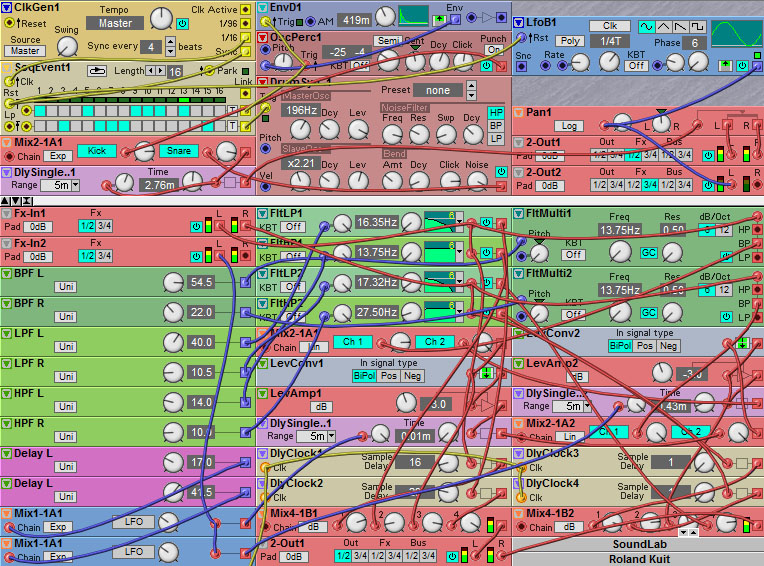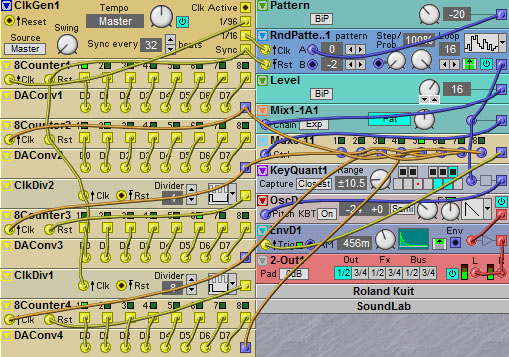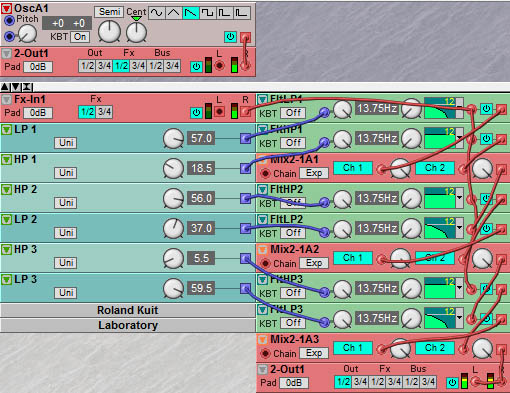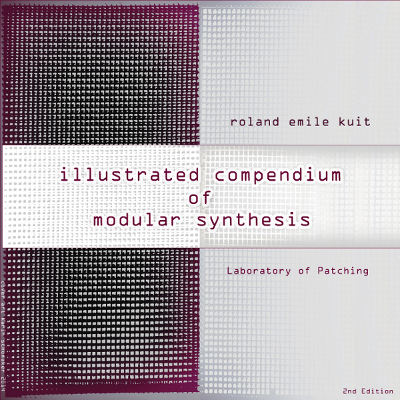Roland Kuit Laboratory of Patching
I usually don’t review stuff here on Progsounds but, believe me, this deserve it. Here is why.
Whoever is into modular programming on Clavia synthesizers already knows the name of Roland Kuit for his great contribution to patcher's community. He is one of few Top Programmers around the world, able to push both generations of Nord Modular synths to their limits. The first eBook (or Patchbook) Roland published was SoundLab I, with over 650 patches, followed by SoundLab II with over 750 patches.
Laboratory of Patching is an interactive HTML Patchbook, meaning that you will need your browser to navigate through the content. Every time you’ll see a screenshot of a patch, simply click on it and your Nord Modular G2 Editor (or Demo, once installed) will open the selected patch.
Laboratory of Patching: Part I (Basic – Intermediate)
This part begins with a brief history of electronic music, focusing on experiments made by pioneers like Stockhausen, Ligeti, Berio and so on. The two Synthesis chapters will explain basics of several sound synthesis techniques, from subtractive to physical modeling with tons of examples. A lot of unconventional and low-level techniques has been used to show the full potential of Clavia modular environment.
Next two chapters show how to build massive patches for Dance and Techno electronic music, with an extended use of sequencer modules. Individual chapters are dedicated to explore specific techniques such as Amp/Ring modulation, Sample&Hold, use and abuse of Logic modules (this is one of my favorite chapters), Audio Processing and Experimental stuff. The final chapter of this first part is a collection of tricks and worths the whole ebook to me since it contains all that “secret magics” a programmer would learn across his life.
Laboratory of Patching: Part II (Advanced)
Second part of this eBook is a collection of advanced techniques, tricks and examples for building exotic patches. Just open Oscillators chapter and you could play with it for years: advanced formant techniques, vocal oscillators, strange PWMs, Wavetables are only few examples of what expects you on this single chapter. Filters chapter is very tasty, since you can find here something like a complex equalizer built around Serge modular techniques or filters made with logic modules (!!!), FIR filters, wave scanners and much more. As I already stated for Part I, Logic section is one of my favorite. On Part II of this book there is another chapter dedicated to abuse of Logic modules that extends the juice you met on Part I with more advanced techniques like Logic Ring Modulation, advanced rhythms and sequencers and even oscillators. Talking of sequencers, there is a dedicated chapter that explores new ways of triggering, sequencing and pattern generation. Next chapter, Miscellaneous, is another impressive collection of tricks spacing from new sync techniques to advanced Phase Locked Loop examples. Next chapter digs into shapers and audio modifiers, from pseudo-stereo to digital emulation of Bode phaser, passing through granular processors, asymmetric signal shaping and other juicy wizardries. Last chapter goes even deeper into sound mangling, leaving you speechless: resonant neurons, coefficient based filterbanks, unconventional bitcrushers are only few examples.
Conclusions
As stated before, this is a work of a lifetime and requires a lifetime to fully explore and understand all the experience Roland put into his amazing book. Every synth programmer, beginner or advanced, will benefit from Laboratory of Patching since it is more a compendium of new ideas than a standard “tutorial like” eBook. Perhaps this is the only downside of this work: while Part I contains brief description of what is going on, Part II only contains patches with their titles. Advanced programmers will not suffer from that, since they can easily understand the whole process while programming, but beginners and intermediate users will be scared at first even if, in my opinion, this is a stimulus to experiment and learn new techniques thinking out of all programming conventions. To me, as programmer, Roland Kuit just created a masterpiece and I can feel the love and even a little of humour behind this work.
From Enrico Cosimi:
Roland Kuit Laboratory of Patching
Di Enrico Cosimi
Ci eravamo recentemente occupati di Soundlab II © e, in quell’occasione, ci eravamo resi conto del più importante pregio dell’opera di Kuit: l’originalità del percorso di programmazione. Questa volta, di fronte al lavoro completo e integrato nelle sue diverse parti, l’impatto è praticamente irresistibile e permette un approccio trasversale tanto alle pratiche di programmazione ad alto livello, quanto a quelle più esoteriche – compiute a basso livello attraverso il collegamento di funzioni più semplici (e per questo, fin troppo spesso sottovalutate).
Contenuto
L’ebook contiene una vera miniera di informazioni, organizzate secondo una solida articolazione:
- Basic I: i principi del suono elettronico illustrati facendo riferimento ad hardware storici e ben noti; tutto quello che c’è dietro oscillatori, filtri, amplificatori, inviluppi, eccetera. I modelli sono i super classici MiniMoog, Korg MS-20, ARP 2600, EMS Synthy, eccetera.
- Basic II: la versione più esoterica – per palati fini – delle tecniche di sintesi al di fuori della norma, comprendendo additiva, sync, vosim, formant, fm, phase distortion, cross modulation, wavetable, physical modeling, pll, granular, eccetera.
- Amplitude Modulation; dal semplice comportamento di modulazione (segnale audio bipolare per segnale di controllo unipolare) alle funzioni di arricchimento timbrico attraverso la generazione delle sideband; la costruzione di circuiti complessi per la AM, la RM bilanciata, il filtraggio su RM nei percorsi di feedback, il gating applicato alla modulazione d’ampiezza.
- Sample & Hold; dal suono del computer impazzito al comportamento di pitch/cutoff/panorama/gate modulation. Tutto il mistero del latching di segnale.
- Audio Processing I: interventi creativi con il clipping del riverbero, la distorsione e i trattamenti non lineari. Sono presenti diverse simulazioni/riprogettazioni di storici circuiti di trattamento audio.
- House/Techno I: l’impiego degli step sequencer e dei generatori di pattern; sound design attraverso phase difference.
- House/Techno II: l’importanza del lavoro attraverso pitch e rhythm, l’incastro orizzontale e verticale nell’impiego ritmico; la costruzione di macchine complesse per la produzione della Intelligent Dance Music.
- Experimental Music: lo sfruttamento creativo dei generatori Random per la produzione di micro/macro strutture di generazione; feedback noise, produttori di scricchiolii, glitch e macchine per il drone. Un paradiso!
- Logic I: moduli On/Off e altri misteri della costruzione funzionale attraverso i pericolosi moduli gialli… il mistero che ha sempre tormentato gli utenti Clavia è finalmente svelato.
- Tips & Tricks: uno zibaldone di suggerimenti legati alla disponibilità di moduli Clavia, ma anche tranquillamente esportabili su qualsiasi piattaforma H/S di sintesi.
- History of Electronic Music and Instruments: enough said…
- Oscillators: guida ai misteri e segreti della generazione timbrica elettronica; strutture conosciute, costruzione di comportamenti dedicati, funzionalità nascoste.
- Filters: il trattamento sottrattivo – ma non solo – nei confronti del contenuto armonico. Possibilità offerte dal filtraggio singolo o multiplo nei confronti del segnale audio naturale.
- Shapers & Audio: trattamenti non lineari e waveshaping per intervenire sul contenuto armonico del segnale passante.
- Logic II: esperimenti di comportamento logico da 1D a 3D nei confronti delle complesse architetture di controllo.
- Patterns & Sequencers: come far comporre alla macchina e come sfruttare creativamente l’automazione esecutiva.
- Miscellaneous: un sacco di roba relativa a inviluppi, granulazione e trattamento del segnale attraverso le linee di ritardo, sintesi RM e FM, eccetera.
- Audio Processing II: strutture inedite per il trattamento del segnale audio mono, stereo o quadrifonico ricevuto dall’esterno. Tecniche per il glitching e il maltrattamento del suono.
Roland!
From Moogulator at Sequencer.de
ROLAND KUIT-LABORATORY OF PATCHING-ELECTRONIC BOOK
patching modular synths, in this case the Clavia G2 is quite easy, as long as you refer to the standard synths you know and possibly let yourself be influenced or inspired by the synths made to date and all those yesterday ones as well. but if you want more out from the machine, want to get inspired or just want to get an idea how an oscillator could be optimized to play with on your patches – this is for you. this is based on HTML so you can watch it in your browser, it’s not meant to be a PDF or “ebook” like ePub – just to be sure what you get filled with countless patch images and the patch files themselves…
right, it is not free and be sure you need some time to read and to really dive into. you may have some experience – I’d recommend to know your synthesis before – like you may have understood your Microkorgs, Jupiters and maybe some Dotcom classic synth or your nice old Roland 100m?
yes – you matched to use them but you always thought there is more to squeeze out of it.
what to expect:
1) an introduction to all kinds of music relevant to “electronic music” of all times since it isn’t just about synthesizers or electronic sounds nowadays, everyone can buy a nice app or purchase a synth for 350€-800€ and don’t ask for “electronic music” which is as much information about the music as “i listen to music with guitars”.
2) anyway – get you copy and start with the music and even examples first, now it’s time for the first chapter – basics. here it’s getting a bit more academic – see all the waveforms, the modules and what they produce – here you go – filters, oscillators, just like manual but tells everything on the Nords components and modules to work with and what you may choose best..
later on – after all those standard modules you find small sets of modules that help to understand how they work and you just need to re-built in on the demo or your own G2, some of those may work on the old Nord Modular and Micro Modular, but this book refers to the G2.
want to know, what is it you may learn here? well, for the envelopes 3 envelopes that trigger each other in a sort of cascade (nice trick!) so it is getting a lot more on tips and tricks now – also some triggering hints given – so there’s plenty of stuff like this starting in the middle of the first basic introduction we might find usefull in our next patches since the next patch may be cool enough to be the only one on stage (check Aalto synth if you need some good inspiration)
later on you’ll find how to model “patch panels” like the MS20 had and how it looks like on the G2 – the whole patch – your screen may need at least the resolution of a current Macbook Air (1360) to see it all without scrolling sideways, but it’s all arranged well. there is an ARP2600, EMS Synthi A to be modeled as well – as far as structure goes, it won’t sound like them, it’s not about emulation (just to mention it here).
additive synthesis is explained as well, and it’s not just some oscs assigned to a mixer and just some envelopes added, but almost some basic approaches to additive synthesis at a glance, and there is more formant and voice synthesis, AM, simple and more complex as well as FM of course ending up in a DX21, sync’ed FM, creation of waveforms by sequencers and everything you need to know about synthesis from waveguide to phase locked loops as an oscillator technique. it’s just SOME modules but you may want to know which one, right? yeaah’ here you go! granular synthesis is in, too! I remember building my first granular synths on the G2, I had a different approach – so it’s nice to see another one… btw learn about what granular really meant in the sense of clouds and grains! no samples envolved!
3) there’s 2 “genre” chapters in it like dance / techno. this is about sequencing, drum sounds, bass lines and creating fatness from oscs and add some extra stuff, including rhythmic variations – the better patches dealing with LFOs that make the groove…
and did I mention you do not have to repatch it all? there’s PCH2 files all over the place – well sorted – so you just need to open the folder and give it a listen and turn and tweak those patches until you like it or understand it and make your own additions…
this is not bound to genres – but to popular music in a very open way of understanding. so – …
4) now it’s getting more and more interesting and more special – there’s one chapter just on amp / ringmod, learn about brown noise to be fed into and make subtle noises, nut just NOISE! this is about electronic patching not just how to use a ring modulator and some bellish results. so why not making the echos more coloured, nebula kind of drone with some little random texture? here it is..
5) sample and hold is much more than just creating arpeggios, stepped random goodness – it can control envelopes to be triggered by very very certain sources of uncertainty! this is for all of you into glitch, IDM, experimental but also into textured drones and a lot more to be fuzzed, chaotisized in a gentle way, just not like on your old ARP2600, there’s much more since you got as many modules as you want – but most patches are not about the number of modules – it’s again what you might now get inspired again by some cool thoughts about randomness, stepps and triggering events by it!
this may be another good chance to make the G2 sound more “analog” as well..
6) algorithmic sequencing and simply changing sounds a different way (Microwave XT users may still love some of those XOR and OR to be attached to LFOs and filters or even oscillators: Logic Modules, this is what happens here, so it will affect sounds and composition structure and possibly makes you create a synth with just a few knobs that change sounds and melodies / patterns to more than variations and possibly mix those to become one interface for both!
Drums that trigger special are in here as well…
7) audio processing doesn’t stop too early as well, there’s reverb simulations via Delays and now’s the time to plug ins drum loops, guitars and harps to be processed by filter banks, vocoders to make something that you may no longer make in guitar rig or buy another FX plugin.
8) the experimental corner may be the most interesting one if it’s about BIG tips and tricks and inspirational things. more complex patches, drones, very special effects
9 to end) – the second part
note that this is a 2 part book- so if you went for the 1st the second won’t repeat the 1st content, it is just like the other chapters – the more you dive in the more creative patches be shown – first things like using sync and wave wrappers with FM within 2-8 modules – just to show you another way to combine interesting osciilators – as long as it is about oscillators and filters this is the succession of where you left off – you haven’t had enough of what others do with their G2 or modular synths? this is a load of simple but helpful additions for a mix of all synthesis methods and how to start an interesting synth with that is NOT AT ALL a minimoog.
same with sequencers and LFOs in the next chapter that introduces a lot of special modules like the DA converter to get very much “shaped” and “organized” random sources which will be valuable for your own sounds! pattern with clock delayed feedback – how does this sound to you? it’s still about 10 modules used, get some quantizers, delays, clock dividers and envelopes into the right place here! learn how to tune the chaos and add even more clever logic modules to get even 8stage tuned patterns and learn how and where to put those level modules to get the right trigger to and from those modules to get the trigger series you want – and tune it!
audio processing and audio / shaping will be what adds coloured reverbs, matrix controlled delay stacks for spectral effects and vocoders with modal resonators (modal synthesis is also on topic with the release of Reaktor 5.(5) – it ends up with resonanting neurons and analog feedback and several methods to generate matrix glitches and shifts of any kind.
yes, you may imagine – this wasn’t made over a week or some nights, this is some of the audio demos.. roughly.
so the second part is for real geeks, if you felt like you are inspired – this may still impress you. as long as you are not one of the 3 or 4 big names I know about G2 patch programming, …
get your copy here: Roland Kuit E-Books
yes, it is 110€ each, discount for students and mass orders (10 or more) if you make a nice group buy, maybe start one in the forum!!! – it’s not “cheap” in a sense of anything – but as you might just see from what I wrote about it you may get the idea whats behind it… – if you want to be on top into the G2 to be on the same level of Reaktor, MAX/MSP and others but without the need of a computer on stage this may be the best you can buy.
A review of James Maier on Carbon111
Laboratory of Patching-Illustrated Compendium of Modular Synthesis
http://carbon111.blogspot.nl/2012/09/roland-kuits-awsome-lab oratory-of.html
"Perhaps you remember my earlier post about his Soundlab II book and patch compilation. Suffice to say Roland Kuit has done it again!
This is one of the most thorough and in-depth collection of instructions and tutorials of modular synthesis it has ever been my pleasure to experience. Some of my favorite areas are the investigations of off-the-beaten-track synthesis methods like Additive, Formant, VOSIM, Physical Modelling, Wave Terrain and Granular, just to name a few.
By all means, please check out Roland's page for a complete explanation of what's on offer in this massive cornucopia of information and sound. It's hard to convey the vast amount of information, audio examples and first-hand-experience included in a package like this.
It is truly astounding!"
Laboratory of Patching
On DJBroadcast by ‘Laboratory Of Patching’ is een indrukwekkend naslagwerk in de vorm van een eBook. Auteur, sound designer en componist Roland Kuit heeft zijn sporen in het modulaire synth-landschap ruimschoots verdiend met naslagwerken als SoundLab 1 en 2, met daarin rond de 700 verschillende manieren om de Clavia Nord Modular synths te programmeren. bevat de eerdergenoemde In het tweede gedeelte komt de meer gevorderde ‘patcher’ aan z’n trekken. Sync-technieken, coefficient based filterbanks, asymmetrische signaalvorming en nog talloze andere toepassingen voor de geeks. Anders gezegd; niet alleen de hardcore modular synthesizer nerd kan z’n geluk op, ook is het een buitengewoon handig naslagwerk om je weer op weg te helpen wanneer je even de (patch)draad kwijt bent.
Few patch examples:


Spectral cross ambiophonics Logic Matrix Loop


Logic Stack multiplexed DAC Pattern 3-Level Filterbank







